Posts Tagged ‘smart on crime’
Posted on: January 27th, 2014 by Smart on Crime
As a Friend of Crime Prevention, I believe that that the heart of crime prevention is through social and community development…..
Imagine neighbourhoods where everyone feels a sense of belonging, where inclusion trumps fear.
Imagine workplaces where people belong, and where respect and collaboration trump power and politics.
Imagine schools where belonging trumps bullying and streaming.
On October 15th, 2013, the New Story Group of Waterloo Region hosted the first of a two day event, “Building a Community of Belonging: It Starts with Conversation” with the second day taking place on November 25th. Facilitator D’Arcy Farlow led the 89 participants, representatives of a number of diverse community sectors thought an interactive process to:
- Discover, what it means to belong in a diverse community,
- Imagine an ideal future where all citizens experience a sense of belonging,
- Create momentum that moves us toward this ideal future
- Sustain communities of belonging through leadership and innovation
John Lord, the founder of the grass-roots organization, The New Story Group of Waterloo Region, was the keynote speaker on October 15th. The New Story Group is dedicated to building inclusive communities where every community member has an opportunity to experience belonging. Our current story has:
- Seniors living alone and very isolated
- People with mental health issues being lonely and having few friends
- New Canadians needing support to enhance their sense of belonging
- Civic Engagement at an all time low
- Access to affordable and social housing is down
- The number of people requiring emergency shelter is up
(Waterloo Region Vital Signs Report, 2013)
I learned a few things during this two day event.
In his keynote address John Lord outlined some of the fundamentals that must exist before people can experience a sense of community belonging:
- Presence –this is a simple as showing up, but we have to make it easy for people to show up!
- Participation – if we make it easy to be present participation becomes easier
- Relationships – as humans we have a strong need for affiliation and relatedness
Building a Community of Belonging is strength-based work. We need to build on the assets of individuals, neighbourhoods, and the wider community. There are four key elements of Leadership and Belonging:
- Intentionality – communities and individuals must be intentional about belonging.
- Belonging Lens – use a belonging lens to guide policy
- Connections – identify bridges to enhance belonging
- Judgement Free Places – people need to be able to enter community spaces and not feel that they are being judged.
The passion and commitment to write a new story was evident amongst the participants. Inspiring speakers, such as Brandon Spunar, of the Connection Project, and founder of Our Common Ground, spoke of his efforts to connect people in our community, to build bridges to inclusion by connecting people with common interests with each other.
The challenge was given to participants to do something, a small thing that would contribute to making their neighbourhood a more welcoming place, something that would contribute to belonging, to do something to help write the new story. Participants committed to doing this and sharing by March with their groups what they have done. Individually they committed to start writing the new story.
Personally I have committed to three actions that will foster community belonging;
- one within my own Forest Heights community,
- one within the City of Kitchener, and,
- the last one that has an impact across the Region of Waterloo.
As a Friend of Crime Prevention, I believe that the heart of crime prevention is social and community development, so I challenge you to become involved, do something to make our region one of belonging, be part of the writing of the New Story of Belonging.
 Author: Doug McKlusky was born in Ottawa but is a long time resident of Waterloo Region including his university days. Doug recently retired from 30 years with the Waterloo Region District School Board. Doug was co-chair of the inREACH Street Gang Prevention Project until it closed in December 2013. But his newly retired days, time has very quickly filled with important work such as Out of the Cold, Nutrition for Learning and the Safe & Healthy Community Advisory Committee for the City of Kitchener. And, wisely, Doug connects all his work to being an all-around ambassador for Friends of Crime Prevention – it really is about connection.
Author: Doug McKlusky was born in Ottawa but is a long time resident of Waterloo Region including his university days. Doug recently retired from 30 years with the Waterloo Region District School Board. Doug was co-chair of the inREACH Street Gang Prevention Project until it closed in December 2013. But his newly retired days, time has very quickly filled with important work such as Out of the Cold, Nutrition for Learning and the Safe & Healthy Community Advisory Committee for the City of Kitchener. And, wisely, Doug connects all his work to being an all-around ambassador for Friends of Crime Prevention – it really is about connection.
Doug McKlusky‘s writing reflects his own opinions and do not necessarily reflect the views or official positions of the Waterloo Region Crime Prevention Council.
Posted on: January 8th, 2014 by Waterloo Region Crime Prevention Council
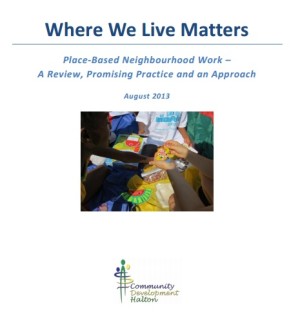 Title: Where We Live Matters | Place-based neighbourhood work – A review, promising practice and an approach
Title: Where We Live Matters | Place-based neighbourhood work – A review, promising practice and an approach
Authors: Jody Orr and staff of Community Development Halton
This new publication from Community Development Halton is a comprehensive read for any community development animator who works directly in neighbourhoods. Recognizing that the landscape of community work has changed dramatically in the past two decades, Orr and her associates urge us to adapt our approaches with the changing needs of our communities. And in case you’ve missed it, communities have changed!
This 70 page publication makes the case for ‘place-based neighbourhood work’ and details an engagement framework (pictured below) – An Approach to Building Neighbourhoods. Community work never follows a linear process and “Where We Live Matters” recognizes that neighbourhoods operate in a cyclical, repeated fashion between all stages of the engagement process depending on the issue or situation and the people involved in the work. It’s messy, chaotic and creative work and it’s hard to capture it accurately on paper!
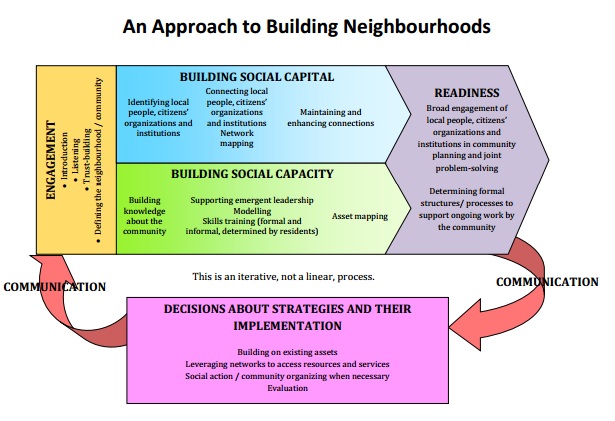
What I like about the model (pictured above) is that they break down the engagement process into more manageable building blocks. I can’t recall ever seeing ‘readiness’ so prominently placed in an engagement process – we all know it’s necessary – so glad to see it named in plain language. I think the distinction between social capital and social capacity is important. Too often, they are used interchangeably, but they truly are distinct concepts in community building.
The remainder of the article outlines:
- the key characteristics of communities in which effective community building processes have been carried out,
- the personal and professional qualities and skills of the people involved in effective neighbourhood work
- best and promising practices in neighbourhood work, focusing on place-based activity
- a brief history of place-based neighbourhood work
When you read the brief history of place-based work (Appendix 1), it’s easy to see how far community work has strayed from the direct neighbourhood level. “Where We Live Matters” urges a shift from the universal, service delivery approaches of the past decades, revisiting the classic community development approach of place-based work. There’s no denying it; there are unique and pressing needs in specific geographic areas of every city, town and municipality. Try as we might, universal approaches will never reach the most vulnerable neighbourhoods in our communities. The work needs to be done where it matters most – in neighbourhoods where people live, and with people who live there.
There’s a subtext to this article that is hard to ignore. It speaks to the role of traditional service delivery institutions, large systems and government social policy. Essentially… these entities are too slow and inflexible enough to respond to the needs of neighbourhoods. Often, these systems and institutions are so policy bound that they actually become an obstacle for the communities they are designed to be helping. Which reminds me of so many stories from the very wise Jim Diers who claims that government and large agencies are often the greatest stumbling block for neighbourhoods and communities.
Isn’t that upside down?
As a community practitioner and animator myself, it’s always refreshing to come across good applied research and this one is solidly rooted in practice and the experience of people working effectively with neighourhoods. The authors draw on the work of pioneers of community work such as:
- Joh McKnight
- John Kretzman
- Bill Lee
- Margaret Wheatley
- Paul Mattessich, Barbara Monsey & Corinna Roy
“Where we live matters” is not new earth-shaking work, but resonates with my own community work as an animator and echoes the growing plethora of place-based initiatives such as:
To better understand the document, check out this Tamarack podcast with Joey Edwardh, Jody Orr and Rishia Burke of Community Development Halton. They lead you through this resource document including an exploration of what inspired the investigation, the important role of an “animator” who enlivens and encourages development in community, funding for work that is hard to measure, and more!
After reading “Where we live matters” I wanted to go pull the McKnight, Kretzman, Lee and Wheatley books from the bookshelf and get reacquainted with the foundations of place-based work. There’s inspiration to be found for our daily work.
But most importantly, “Where we live matters” reminds us that what goes on in our neighbourhoods and the quality of life there has the greatest impact on our quality of daily living. We absolutely should be investing in neighbourhoods.
Posted on: December 31st, 2013 by Waterloo Region Crime Prevention Council
I just love this time of January when you get to take a look back at what’s been accomplished over the past year, ponder what worked well and scratch your head about what emerged that you never expected.
As we turn the page into 2014, I also love the tradition of digging into our blog to find what you, the readers, found most interesting over the last year. With over 45 blog posts in 2013, there was certainly something for everyone. We had 23 different guest bloggers contribute community responses on the root causes of crime as part of the Snapshot in Time: Root Causes of Crime in Waterloo Region. You can find all the posts and community responses in one tidy corner of the blog.
But, our readers are diverse which indicates why our most popular blogs on Smart on Crime ranged from book reviews to casinos and from guest commentary to provincial budget analysis. Here’s the round up of our top 13 posts from 2013.
1. The local impact of youth unemployment/underemployment – guest post by Carol Simpson
“If youth in the labour market cannot find employment, they find it increasingly difficult to become established in the “adult” world. They have done nothing wrong. They have done what they were told to do and were supposed to do yet cannot find that suitable connection to the workforce. This impacts their confidence and their ability to “fit in”. Many have chosen to give up and have simply walked away from the labour market making it even harder to find their “place” in the world. This results in frustration and anger and they feel neglected.”
2. What we’re reading: Rescuing Policy – by Anthony Piscitelli
“How can government solve the complex issues facing society?”
3. Children in care in Waterloo Region: Compounding risk for vulnerable children – by Jill Stoddart
“Children living in the care of the child welfare system have a higher likelihood of justice system involvement in comparison to children living with their biological parents”.
4. Excuse me Waterloo Region, your homelessness is showing – by Lynn Macaulay
“I feel part of a sector where I join in solidarity with people experiencing homelessness and many community members who together stand up to say – people who are homeless matter. We collectively are committed to ending homelessness in Waterloo Region. This is a lofty goal, which will take much persistence and hard work, but with the determination and skills of this community, I believe it is possible.”
5. Income of low income families: Root cause of crime in Waterloo Region – by Anthony Piscitelli
Neighbourhoods that are at an economic disadvantage when compared to other areas report higher crime rates. In addition, societies where wealth is concentrated amongst a small group of individuals report higher crime rates.
6. Through the eyes of crime prevention: Ontario 2013 Budget – prepared by Alexadra Kraushaar

7. The day I went to prison – by Andrew Jackson
“Five minutes later I stood at the front of a classroom with 25 women waiting for me to start talking. “Good morning” I said. “Good morning.” came the reply from the women of Grand Valley Institution for Women (GVI).”
8. Knowing other people care: The importance of community to women who have experienced homelessness – by Elizabeth Clarke
“It goes almost without saying that the overarching cause of homelessness is poverty, but not all people who are poor become homeless. Not all people who become homeless stay that way for long.”
9. Waterloo Region’s Catholic Schools: Laying a solid foundation for student success – by David DeSantis
“It is no surprise that the length of involvement in schooling significantly impacts participation in criminal activity and the probability of incarceration, as found in Snapshot in Time: Root Causes of Crime in Waterloo Region. In fact, this has been well-known in the education sector for many years – which explains the great lengths to which school boards go in mitigating against this problem.”
10. 7 things we learned from Alan Quarry about social media for social change – by Juanita Metzger
“Creating change that lasts happens in relationships, from one person to another, and these days, often facilitated with the power of social media. Here are Alan’s 7 best thoughts on the principles for engaging people in change.”
11. A Snapshot in Time: The Root Causes of Crime in Waterloo Region – by Anthony Piscitelli
“The Waterloo Region Crime Prevention Council believes monitoring the root causes of crime can aid the community in addressing crime, victimization and fear of crime through awareness, discussion, leadership and action. Once the root causes are understood more clearly, resources can be applied to areas where the community is doing poorly. A Snapshot in Time: The Root Causes of Crime in Waterloo Region identifies the root causes of crime right here in Waterloo Region and provides a tool to aid local policy makers in targeting interventions to where they are most needed and where they can have the greatest impact.”
12. Poverty in Waterloo Region… Is that REALLY OK with you? – by Mary MacKeigan
“The data in the section of Root Causes of Crime in Waterloo Region titled Income of Low Income Families is no surprise to those of us who are familiar with poverty-related issues in our regional community. In fact, in Waterloo Region, 36 earners make more than $2.57M; 360 make more than $685K; 3,610 (the top 1%) make more than $396K. Individuals who make more than $81,200 are in the top 10%. On the other hand, the median income of the bottom 50% is $14,100!* In 2007, one third of employed individuals were earning $14.00/hour or less. This is poor – it may not be deep (or absolute) poverty, but it is precariously close to it. “
13. What are the odds? The vulnerable child of today as the problem gambler of tomorrow – by Chris Sadeler
“The official position statement of the Waterloo Region Crime Prevention Council given at a public consultation on the question of a casino in the City of Kitchener. The remarks were given by WRCPC Executive Director, Christiane Sadeler on behalf of the Waterloo Region Crime Prevention Council.”
So many great reads from 2013. But if you’re in the mood for something to watch, rather than read, might I suggest our personal favourite, “Won’t you be my neighbour?” Who can resist Anthony Piscitelli’s homage to Mr. Rogers!
We look forward to bringing more great smart on crime blogs for you to ponder. Better yet, we love hearing your comments, reactions and responses to the posts and guest commentaries. We look forward to hearing more from you in 2014!
Posted on: December 17th, 2013 by Waterloo Region Crime Prevention Council
The crime rate records the amount of police reported crime per 100,000 people. In this number, all crimes are counted equally. This represents approximately one third of the crime that occurs in Canada; this varies by jurisdiction and type of crime. The Crime Severity Index and the Violent Crime Severity Index weight crimes according to their severity based upon average sentencing outcomes. Crime and violence severity indices address the crime rate being driven by high-volume offences that are of a less serious nature.
The Statistics
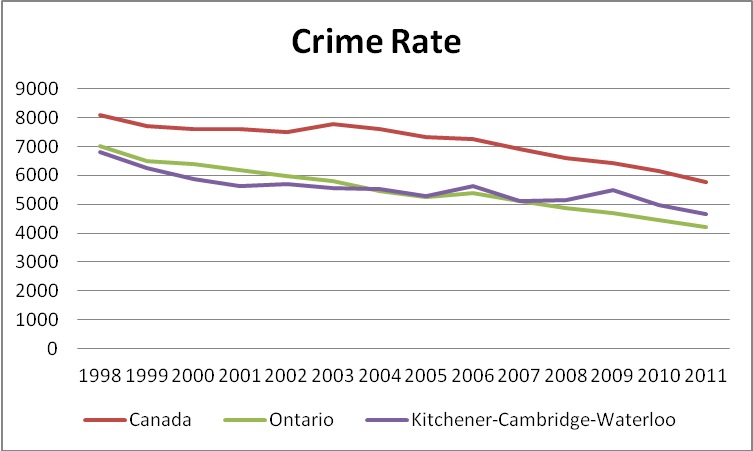
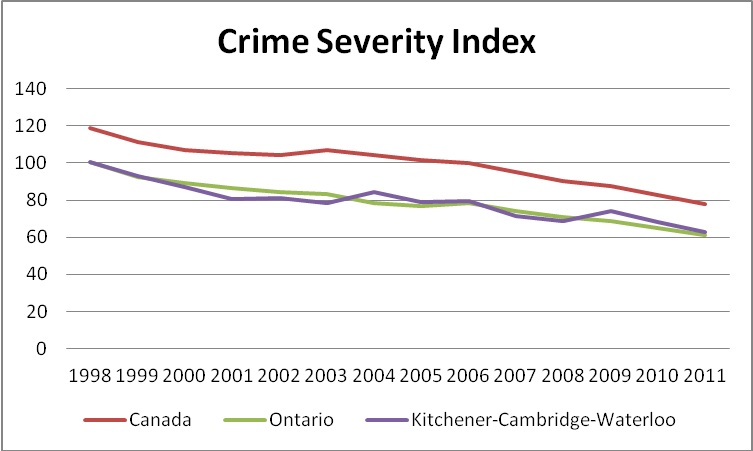
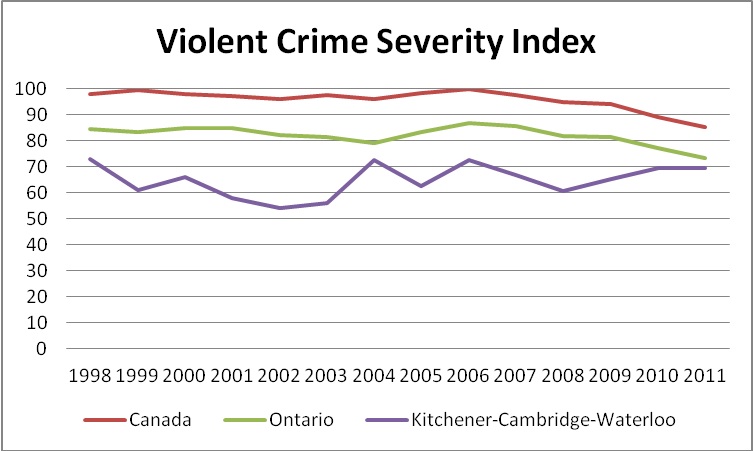 Date Sources: Statistics Canada, Uniform Crime Reporting Survey: CANSIM Table 2520051
Date Sources: Statistics Canada, Uniform Crime Reporting Survey: CANSIM Table 2520051
Statistics Canada, Uniform Crime Reporting Survey: CANSIM Table 2520052 (Released Annually)
The Story Behind the Numbers
Posted on: December 4th, 2013 by Waterloo Region Crime Prevention Council
Communities with a higher proportion of lone-parent headed households are associated with higher crime rates. Children from lone parent headed households face low incomes and other significant risk factors for becoming a victim or perpetrator of crime. The chart below tracks percentage of lone parent families in Waterloo Region and Ontario. The second chart tracks two parent family median incomes and single family median incomes. The gap between the two assesses whether single-parent headed households are falling behind when compared to two parent households.
The Statistics
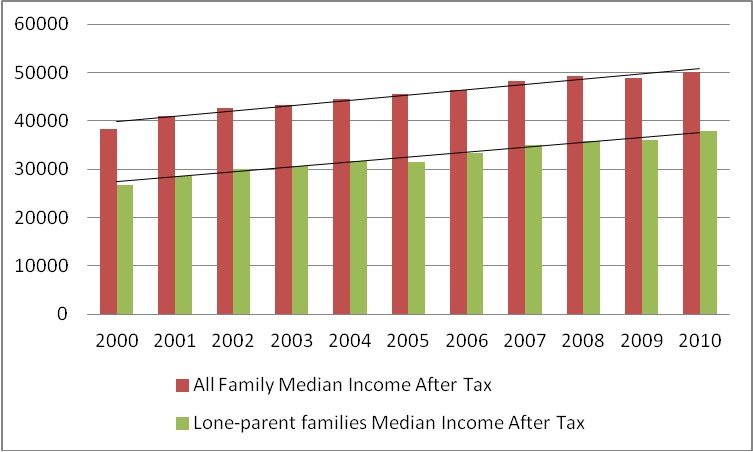
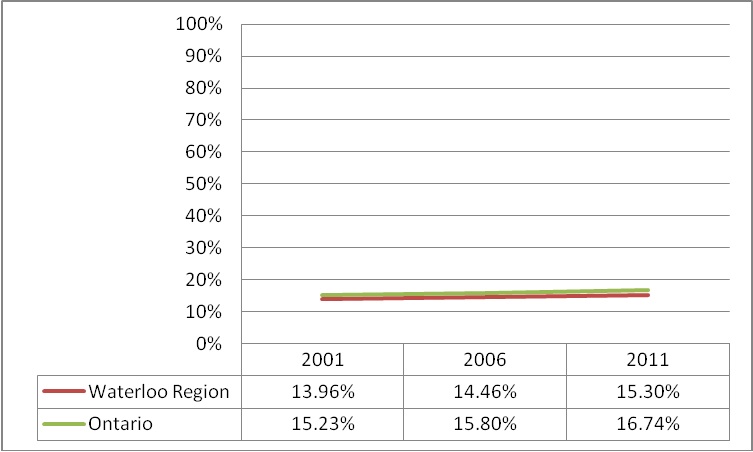 Data Sources: Statistics Canada, Census (Released Every Five Years); Statistics Canada, CANSIM Table 111-0015 (Released Annually)
Data Sources: Statistics Canada, Census (Released Every Five Years); Statistics Canada, CANSIM Table 111-0015 (Released Annually)
The Story Behind the Numbers
Waterloo Region has less single parent headed households than Ontario. However, single parent families have increased in Ontario and Waterloo Region over the past ten years. Interestingly in Waterloo Region the income of single parent headed households is growing slightly faster than two parent families in the Kitchener-Cambridge-Waterloo CMA. So while single parent headed households are growing in the region their income is keeping pace with average incomes, unfortunately they are not making any significant gains to close the gap.
Read the Community Response:
Single Parent Headed Households: A response from Big Brothers Big Sisters of Waterloo Region with Julie Philips
Posted on: December 4th, 2013 by Smart on Crime
To take a deeper look at the Single Parent Headed Households indicator in Snapshot in Time: Root Causes of Crime in Waterloo Region, we talked to Julie Philips, Chief Operating Officer for Big Brothers, Big Sisters of Waterloo Region.
1. What is your response to the data presented on this indicator/variable? How does it make you feel when you reflect on this indicator?
People often assume that children raised in a lone-parent family are more likely to live in poverty and are also more likely to commit crime. I would venture to say that children and youth from fragmented households are perhaps just as likely to commit crime as lone-parent offspring. What do I mean by fragmented? A two parent family, where the parents are too busy to invest time in their children. Parents who at the end of the day are too tired, burned out and stressed, leaving little time or energy to actively engage their children. Parents who create an unstable home life thus leaving their children to find their own sense of belonging, their network of support.
2. Who is involved in addressing this issue in your sector? What are you already doing about it?
Many organizations, both formal and informal are working to address this issue. Schools, teachers, faith communities, neighbourhood associations to social service agencies are working individually and as a collective to provide healthy networks of support for children and youth in our region regardless of family structure.
We believe in working with others to promote healthy and safe environments for children. Our programs are not “cookie-cutter or clinical” but are based on the power of friendship – having someone special to spend time with and count on. We have passion for excellence and our programs evolve with the emerging needs of our community through collaborative efforts and leveraging collective resources. Our programs are child-centered and therefore allow each child to be supported in a way that helps them reach their individual goals.
Children in our community based programs are primarily from lone-parent families or extended families.
One-to-One matches children and youth with the support of a caring adult mentor. The goal is that children and youth become empowered to reach their potential as engaged, confident and well-rounded individuals who are able to develop and maintain positive relationships.
Big Bunch provides children and youth with mentoring support through group programming. By participating in recreational opportunities, children and youth develop and maintain positive relationships, and become confident, engaged members of their community.
Children in our school based and summer programs are from a variety of family structures.
In-School Mentoring provides elementary students who could benefit from extra emotional, social or academic support, with a caring adult mentor. The goal is for students to become engaged, connected, contributing, skilled, and confident members of their school and community, empowering them to reach their potential.
Go Girls! Healthy Bodies Healthy Minds is designed for girls aged 12-14 and provides them with information to help make informed choices about healthy, active living and supports them in dealing with the emotional, social and cultural issues they may face. The goal of the program is that participants have a positive body image, high self-esteem, healthy eating habits, be physically active, and able to create and maintain healthy relationships.
Game On! uses a mentor approach to provide boys and young men with information and support to make informed choices about a range of healthy lifestyle practices. Through non-traditional physical activities, complemented with healthy eating support, participants are engaged in life skills, communication, and emotional health discussions designed to engage participants in the pursuit of life-long healthy lifestyles.
Summer Discovery supports children during the summer months. They enjoy all that summer has to offer games, crafts, activities and snacks! This day program is about having fun and building friendships, while learning and participating in physical activity together.
3. What else should be done and/or needs to be done about it?
There also needs to be greater engagement of children and youth in the process. Access to services and supports need to be simplified – it is currently too easy to get frustrated or lost in the system when trying to access support. A greater focus should be given to providing proactive rather than reactive strategies. We need to work towards removing the stigma sometimes felt by parents/families access services. The community as a whole needs to work collaborate to holistically address the needs of children and youth in the Region. This means valuing the working of the services providers and committing to sustainable revenue sources for service providers.
Thank you Julie! Thanks for your insights & responses.
 Author: Julie Phillips, a native of Cambridge, has an interest for world missions as well as local outreach. As the former Executive Director with Big Brothers Big Sisters of Cambridge she played a key role in the successful merger of the Cambridge and Kitchener-Waterloo chapters. With 12 years of experience in the non-profit sector and as Chief Operating Officer of Big Brothers Big Sisters of Waterloo Region she works towards providing youth in her community with the same opportunities she had when she was growing up. Julie is an active volunteer in her community and is passionate about the social issues affecting the well-being of our region’s residents.
Author: Julie Phillips, a native of Cambridge, has an interest for world missions as well as local outreach. As the former Executive Director with Big Brothers Big Sisters of Cambridge she played a key role in the successful merger of the Cambridge and Kitchener-Waterloo chapters. With 12 years of experience in the non-profit sector and as Chief Operating Officer of Big Brothers Big Sisters of Waterloo Region she works towards providing youth in her community with the same opportunities she had when she was growing up. Julie is an active volunteer in her community and is passionate about the social issues affecting the well-being of our region’s residents.
Posted on: November 21st, 2013 by Smart on Crime
A woman’s purse is snatched as she walks downtown. A youth is swarmed and attacked by four other youth. A man pounds on his neighbour’s door, uttering threats when she refused to return his son’s football. The woman fears leaving her home. Fear of crime can skyrocket for such victims of crime. Trouble concentrating, hyper-vigilance, and a generalized feeling of being unsafe may ensue. Crime victims may install alarm systems, seek Peace Bonds, or relocate, but an increased fear of crime may persist. Friends and family, hearing about the crime, may also fear crime more.
Restorative justice can dramatically reduce crime victims’ post-traumatic stress symptoms and fear of crime. Restorative justice is a voluntary process that brings together the victim, perpetrator, and their supporters with trained facilitators to talk about how they have been affected by the crime, and who needs to do what to make things as right as possible. Community Justice Initiatives (CJI) in Kitchener has been a leader in this worldwide movement for nearly 40 years.
Carol, who was hit over the head with a broken bottle as her purse was snatched, had missed many days at work, overwhelmed by fear. In the seven months since the incident, she had been unable to face buying a new purse. When Carol and her daughter met with the perpetrator, Brianna, and Brianna’s grandmother in a facilitated process, Carol and her daughter described the far-reaching effects of the incident. Carol learned about Brianna’s traumatic history and ensuing drug habit that led to the robbery. She saw how upset Brianna’s grandmother was by Brianna’s behavior, and Brianna’s repentance and efforts to get on the right track. She learned Brianna was not the monster that she had imagined her to be, but a troubled young woman who had been the past victim of rape and abuse, trying to turn her life around. Carol’s fear was transformed. On the way home from the restorative justice process, she bought a new purse and returned the next day to work with confidence.
Vigit, who had been swarmed and hit by four other youths, no longer needed to look around anxiously as he left the house after he participated in a restorative justice process. In a follow-up interview, Vigit said, “It was great to get together with the individuals to discuss what happened. I was personally attacked and felt really unsafe at the time. This gave me peace of mind, and helped everyone move on.”
Similarly, Barbara, who was living in fear following threats Bill shouted while pounding on her door, experienced not only a renewed sense of safety, but deep compassion and support from her neighbours, who learned, as an outcome of the process, that her husband was dying of cancer. The football had come into her yard one too many times, and had damaged a birdbath made by her husband. Bill not only apologized for his threatening behavior and for bad-mouthing her character to all the neighbours. He volunteered to go around to all the neighbours and explain what had happened. The neighbours also came up with a new place for the youth to play football.
Research shows that burglary and robbery victims who go through a restorative justice process have a dramatic reduction in post-traumatic stress symptoms compared to those who don’t. Fear of crime drops not only for the direct victim, but for family, friends and neighbours, too, as they see the person responsible for the harm held accountable, apologize and take steps to repair the harm.
Just as a restorative justice process for cases before the courts can reduce fear of crime, use of restorative justice in schools can help to build a stronger sense of safety and community. Schools that use restorative justice to address crime and harm have lower suspension rates and higher perceptions of safety by staff and students. This typically leads to a more effective learning environment, less absenteeism of staff and students, and higher student achievement levels.
Restorative justice can also be used within the community to help people resolve escalating tensions between neighbours, on sports teams, or within housing developments. After meeting with trained mediators and addressing the underlying issues behind people’s positions, the fear of violence erupting is replaced with new understanding and a mutually acceptable way forward.
Contact Community Justice Initiatives for more information about restorative justice, or to explore using a restorative justice process to address a particular crime, harm or conflict. Be part of the movement to build healthier communities and reduce the fear of crime.
Community Justice Initiatives
49 Queen St. N—3rd floor
Kitchener, Ontario N2H 2G9
info@cjiwr.com | 519-744-6549
 Author: Sue Klassen is completing her Masters in Conflict Transformation, with concentrations in Restorative Justice and Trauma Healing. As past president of Partners in Restorative Initiatives, a restorative justice agency in Rochester, NY, she has 12 years experience in working with restorative justice and trauma in courts, schools and the community, as a facilitator, trainer and advocate.
Author: Sue Klassen is completing her Masters in Conflict Transformation, with concentrations in Restorative Justice and Trauma Healing. As past president of Partners in Restorative Initiatives, a restorative justice agency in Rochester, NY, she has 12 years experience in working with restorative justice and trauma in courts, schools and the community, as a facilitator, trainer and advocate.
Find more responses about fear of crime:
Posted on: November 19th, 2013 by Waterloo Region Crime Prevention Council
Fear of crime may cause an increase in crime within a community. Although there is not a consensus in the literature around this point, it is clear that fear of crime is unwelcome and tends to negatively impact quality of life. Fear of crime is measured in this survey as the percentage of respondents indicating they feel very unsafe, or somewhat unsafe, walking alone in their area after dark.
The Statistics
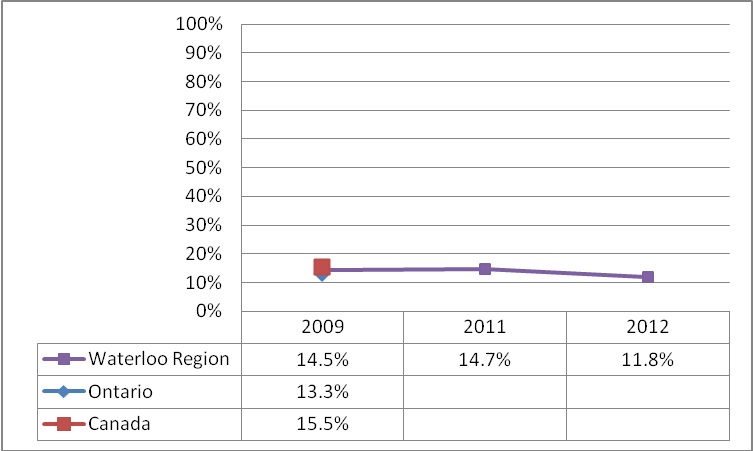 Data Sources: Statistics Canada General Social Survey Victimization Cycle (Released Every Five Years) University of Waterloo Survey Research Centre Local Area Survey (Released Annually)
Data Sources: Statistics Canada General Social Survey Victimization Cycle (Released Every Five Years) University of Waterloo Survey Research Centre Local Area Survey (Released Annually)
The Story Behind the Numbers
Levels of fear of crime in a community are expected to be relatively stable in the short term. Locally, levels of fear of crime are stable with changes within the margin of error. Comparing Waterloo Region to Ontario and Canada, the numbers are relatively similar with Waterloo Region appearing to have a slightly lower fear of crime than Canada.
Read the Community Responses:
Posted on: November 19th, 2013 by Smart on Crime
There has long been a perception that Kitchener’s downtown core is more unsafe than other downtowns and neighbourhoods in our Region. To dig deeper into the Snapshot in Time: Root Causes of Crime in Waterloo Region indicator on fear of crime, we tracked down the Mayor of Kitchener, Carl Zehr.
1) What is your response to the data presented on the fear of crime indicator? How does it make you feel when you reflect on this indicator?
The indicators in this report are generally not surprising to me since they reflect other statistics I have seen. While this region is often expected to do better than the rest of the province and country, it is clear that we are very similar to other CMA’s in Canada. There are a few areas where we rank a bit better in the indicators but it is clear that the general economic success of the region enjoys does not translate to every sector of our community. Given the recent information regarding crime in the downtown versus suburbs, we continually need to deal with the perception of crime versus the reality. The perception is the downtown is not safe – the reality is it’s growing, has changed dramatically and if crime is an issue, it’s more outside of the downtown. Perceptions need to change too. We therefore, collectively, have a lot more work to do.
2) Who is involved in addressing this issue in the community? What are you already doing about it?
Through the programs the city supports at the community centres and neighbourhood associations, many people have been busy providing value added and positive activities for the community as a whole, and, especially for youth. There are many independent not-for-profit organizations in the city and community that are also providing services and programs which allow people of all ages to “stay out of trouble”. Kitchener and other local governments provide funding for many of these organizations even though “it is never enough”.
Economic and education opportunities have a significant impact on crime rates. Indirectly the city’s economic development division helps the cause by working to create the climate for entrepreneurs and companies to succeed.
3) What else should be done and/or needs to be done about it?
As noted above, we have many organizations doing good work but I think the fact that there are so many may be holding the community from improving our ranking. Organizations and funding bodies, including governments, of these organizations need to give serious consideration to eliminating duplication of service and programs so that more resources can be directed towards to the programs and away from administration.
Many of these various agencies (connected to this issue and others) appear to be so competitive and spend a lot of time figuring out how to survive (writing grants, etc.) rather than working collaboratively or merging to improve programming/services. Streamlining services to have one access point helps people figure out where to get help. The Community Support Connections model, which merged 4 seniors’ agencies, is a good model and not many have followed it.
Thank you Mayor Zehr, for your insightful responses.
What do you think about fear of crime in Waterloo Region neighbourhoods?
Read more community responses about fear of crime:
Posted on: November 12th, 2013 by Waterloo Region Crime Prevention Council
Social capital refers to the human connections and capacities that contribute to the wealth and well being of a community. Social capital is developed in many ways such as participating in community groups, helping someone solve a problem or by saying hello to a neighbour. High levels of social capital have been linked to reduced violence in neighbourhoods. A community characterized by strong interpersonal connections helps to reduce crime by making it more likely that people in the community will watch over the neighbourhood. A simple and widely accepted measure of social capital asks the question, ‘Generally speaking, would you say that most people can be trusted or that you cannot be too careful in dealing with people?’
The Statistics
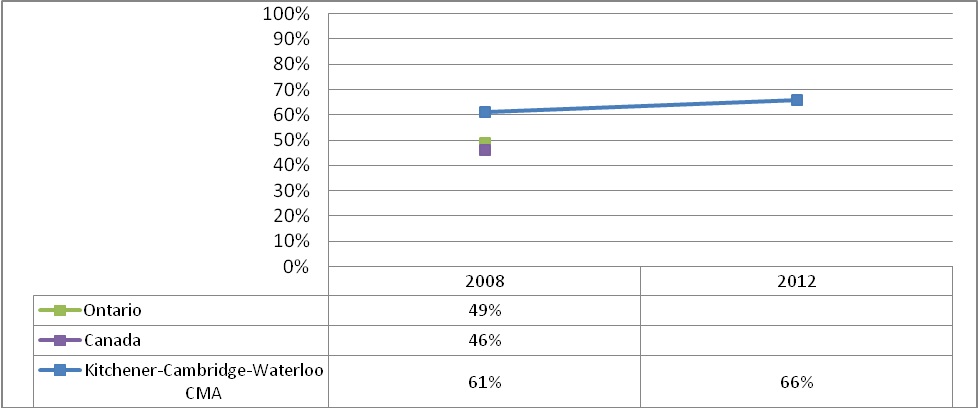
Data Sources: Statistics Canada, General Social Survey Time Use Cycle (Released Every Five Years); University of Waterloo Survey Research Centre, Local Area Survey (Released Annually)
The Story Behind the Numbers
Social trust is slightly higher in Ontario than it is in Canada and it is significantly higher in the Kitchener-Cambridge-Waterloo Census Metropolitan Area (CMA). Similar results were found on a second question in the 2008 General Social Survey, asking how much respondents trust people in their neighbourhood. The results bode well for Waterloo Region and present an important protective factor for the community. The increase in social capital between 2008 and 2012 is within the margin of error, indicating that social capital in the region is stable. Social capital does not form by itself. It tends to be the outcome of strategic and focused efforts on behalf of local institutions including the grass roots and local government to ensure an informed and engaged citizenry.
Read the Community Responses:
Life at 17 by Karen Scian, Waterloo City Councillor, Conestoga College instructor, Waterloo Public Library Trustee, Chair of the Board for Community Justice Initiatives
 Author: Doug McKlusky was born in Ottawa but is a long time resident of Waterloo Region including his university days. Doug recently retired from 30 years with the Waterloo Region District School Board. Doug was co-chair of the inREACH Street Gang Prevention Project until it closed in December 2013. But his newly retired days, time has very quickly filled with important work such as Out of the Cold, Nutrition for Learning and the Safe & Healthy Community Advisory Committee for the City of Kitchener. And, wisely, Doug connects all his work to being an all-around ambassador for Friends of Crime Prevention – it really is about connection.
Author: Doug McKlusky was born in Ottawa but is a long time resident of Waterloo Region including his university days. Doug recently retired from 30 years with the Waterloo Region District School Board. Doug was co-chair of the inREACH Street Gang Prevention Project until it closed in December 2013. But his newly retired days, time has very quickly filled with important work such as Out of the Cold, Nutrition for Learning and the Safe & Healthy Community Advisory Committee for the City of Kitchener. And, wisely, Doug connects all his work to being an all-around ambassador for Friends of Crime Prevention – it really is about connection.
 Title:
Title: 



 Date Sources: Statistics Canada, Uniform Crime Reporting Survey: CANSIM Table 2520051
Date Sources: Statistics Canada, Uniform Crime Reporting Survey: CANSIM Table 2520051
 Data Sources: Statistics Canada, Census (Released Every Five Years); Statistics Canada, CANSIM Table 111-0015 (Released Annually)
Data Sources: Statistics Canada, Census (Released Every Five Years); Statistics Canada, CANSIM Table 111-0015 (Released Annually) Author: Julie Phillips, a native of Cambridge, has an interest for world missions as well as local outreach. As the former Executive Director with Big Brothers Big Sisters of Cambridge she played a key role in the successful merger of the Cambridge and Kitchener-Waterloo chapters. With 12 years of experience in the non-profit sector and as Chief Operating Officer of
Author: Julie Phillips, a native of Cambridge, has an interest for world missions as well as local outreach. As the former Executive Director with Big Brothers Big Sisters of Cambridge she played a key role in the successful merger of the Cambridge and Kitchener-Waterloo chapters. With 12 years of experience in the non-profit sector and as Chief Operating Officer of Author: Sue Klassen is completing her Masters in Conflict Transformation, with concentrations in Restorative Justice and Trauma Healing. As past president of Partners in Restorative Initiatives, a restorative justice agency in Rochester, NY, she has 12 years experience in working with restorative justice and trauma in courts, schools and the community, as a facilitator, trainer and advocate.
Author: Sue Klassen is completing her Masters in Conflict Transformation, with concentrations in Restorative Justice and Trauma Healing. As past president of Partners in Restorative Initiatives, a restorative justice agency in Rochester, NY, she has 12 years experience in working with restorative justice and trauma in courts, schools and the community, as a facilitator, trainer and advocate. Data Sources: Statistics Canada General Social Survey Victimization Cycle (Released Every Five Years) University of Waterloo Survey Research Centre Local Area Survey (Released Annually)
Data Sources: Statistics Canada General Social Survey Victimization Cycle (Released Every Five Years) University of Waterloo Survey Research Centre Local Area Survey (Released Annually)